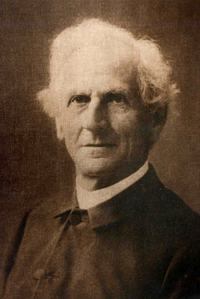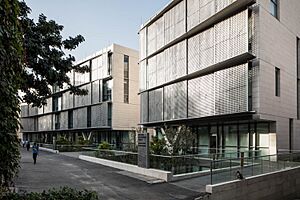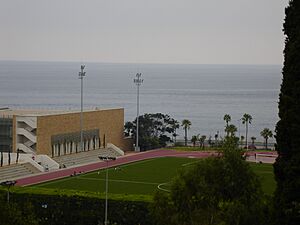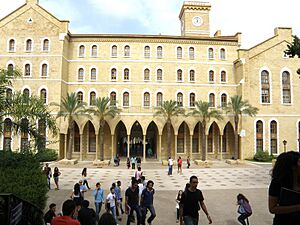American University of Beirut facts for kids
|
الجامعة الأميركيّة في بيروت
|
|
|
Former name
|
Syrian Protestant College (1866–1920) |
|---|---|
| Motto | Ut vitam abundantius habeant (Latin) |
|
Motto in English
|
That they may have life and have it more abundantly |
| Type | Private university |
| Established | 1866 |
| Endowment | $779.3 million (2020) |
| Chairman | Abdo G. Kadifa |
| President | Fadlo R. Khuri |
|
Academic staff
|
1,200 instructional faculty |
|
Administrative staff
|
4,340 |
| Students | 9,408 (2019) |
| Undergraduates | 7,782 (2019) |
| Postgraduates | 1,626 (2019) |
| Location |
,
Lebanon
33°53′59.87″N 35°28′56.22″E / 33.8999639°N 35.4822833°E |
| Campus | Urban, 61-acre (250,000 m2); and a 247-acre (1.00 km2) research farm in Beqaa Valley |
| University Press | AUB Press |
| Colors | Burgundy (color) & white |
| Mascot | Phoenix |
 |
|
The American University of Beirut (AUB) is a private university in Beirut, Lebanon. It is an independent school that offers many different study programs. Students can earn bachelor's, master's, and PhD degrees.
AUB has a large budget and a campus with 64 buildings. These include the American University of Beirut Medical Center (AUBMC), four libraries, three museums, and seven dorms. Many students come from outside Lebanon to study here. AUB graduates live in over 120 countries around the world. Classes at AUB are taught in English. The degrees from AUB are officially recognized in New York, USA.
Contents
History of AUB
The idea for AUB started on January 23, 1862. A man named W. M. Thomson suggested creating a college in Beirut. This college would also offer medical training. Dr. Daniel Bliss was chosen to be its first president.
On April 24, 1863, the State of New York officially approved the college. It was first called the Syrian Protestant College. The college opened on December 3, 1866, with 16 students. Daniel Bliss was president until 1902. In 1920, the college changed its name to the American University of Beirut.
At first, classes were taught in Arabic. This was because Arabic was the main language in the region. Later, in 1887, English became the language of instruction.
Many AUB graduates have become important leaders around the world. For example, 20 AUB alumni helped sign the United Nations Charter in 1945. This was more than from any other university. AUB graduates continue to work as presidents, prime ministers, and leaders in many fields. They work in governments, businesses, and other organizations.
During the Lebanese Civil War (1975–1990), AUB worked hard to keep teaching. They even made agreements with universities in the United States. Sadly, some university staff were kidnapped during this time. In 1984, AUB President Malcolm H. Kerr was killed. In total, 30 people connected to the university were kidnapped during the war.
On November 8, 1991, a car bomb destroyed the main office building. One staff member died in this attack.
AUB opened a new campus called AUB Mediterraneo in Paphos, Cyprus. This new campus officially opened on September 4, 2024.
AUB Presidents
Here is a list of the university presidents since it began:
- Daniel Bliss (1866–1902)
- Howard S. Bliss (1902–1920)
- Bayard Dodge (1923–1948)
- Stephen B.L. Penrose Jr. (1948–1954)
- Constantin Zureiq (1954–1957)
- J. Paul Leonard (1957–1961)
- Norman Burns (1961–1965)
- Samuel B. Kirkwood (1965–1976)
- Harold E. Hoelscher (1977–1981)
- Malcolm H. Kerr (1981–1984)
- Calvin Plimpton (1984–1987)
- Frederic P. Herter (1987–1993)
- Robert M. Haddad (1993–1996)
- David S. Dodge (1996–1997)
- John Waterbury (1997–2008)
- Peter F. Dorman (2008 – June 2015)
- Fadlo R. Khuri (September 2015–present)
AUB Campus
The AUB campus is about 61 acres large. It sits on a hill that looks out over the Mediterranean Sea. The campus has 64 buildings, seven dorms, and several libraries.
Students can also use the Charles W. Hostler Student Center. There is an Archaeological Museum and a Natural History Museum. AUB also has a 247-acre research farm in Beqaa, Lebanon. This farm is used for agricultural studies. The AUB Mediterraneo campus is located in Paphos, Cyprus.
AUB Faculties (Schools)
AUB has several faculties, which are like different schools within the university:
- FAFS, Faculty of Agricultural and Food Sciences
- FAS, Faculty of Arts and Sciences
- FHS, Faculty of Health Sciences
- FM, Faculty of Medicine
- HSON, Rafic Hariri School of Nursing
- MSFEA, Maroun Semaan Faculty of Engineering and Architecture
- OSB, Suliman S. Olayan School of Business
AUB Students
In the fall of 2018, more than 9,000 students were studying at AUB. This included over 7,000 undergraduate students and nearly 2,000 graduate students.
AUB Academics
AUB offers 141 different study programs for undergraduate and graduate students. It also has 36 certificates and diplomas. In 2007, the university started offering PhD programs again. AUB also has many research centers. These centers support and promote research in various fields.
University Rankings
The QS University Rankings for 2026 placed AUB as the 237th best university in the world. It was also ranked 6th in the Arab world.
AUB Medical Center
The AUB Medical Center (AUBMC) is a private teaching hospital for the Faculty of Medicine. It is a large hospital with 420 beds. AUBMC offers many medical services and training programs for doctors and nurses.
Throughout its history, AUBMC has helped people during conflicts. It cared for injured people during World War I and World War II. It also helped during the Lebanese Civil War and other conflicts. In recent years, it has provided care for Syrian refugees.
AUB's medical services have included a nursing school since 1905. In 2008, AUB's Rafic Hariri School of Nursing became a member of a major American nursing organization. AUBMC also received a special award called the Magnet designation in 2009. It was the first hospital in the Middle East to get this award.
AUBMC now includes several buildings. These include the Rafic Hariri School of Nursing Building and the Pierre Abu Khater Outpatient Building. There are also many special centers for research and patient care. These centers study health issues common in the Arab region, like cancer and heart disease.
In May 2019, AUBMC began a new expansion project. This project will make the Medical Center even bigger and better.
American University of Beirut Press
The American University of Beirut Press (also called AUB Press) is a publishing house. It is supported by the American University of Beirut. The press publishes books and collections about Lebanon and the Middle East.
The AUB Press started in its current form in 1969. It began publishing books under the "American University of Beirut Press" name in 2001.
AUB Museums and Collections
AUB has three museums: the Archaeological Museum, the Geology Museum, and the Natural History Museum.
The Archaeological Museum is one of the oldest museums in the Near East. It has over 16,000 objects and 10,000 coins. The collection includes ancient pottery, tools, sculptures, and Egyptian vases. The museum has also done its own excavations in Lebanon and Syria.
The Geology Museum displays rocks, minerals, and fossils from all over the world.
The Natural History Museum has a special collection of plants and animals from the area. It is famous for its Post Herbarium, which has 63,000 plant samples.
AUB's Archives and Special Collections holds important historical documents. These include papers about the founding of the university in 1866. They also have maps, photos, and posters about Lebanon and the region. One special item is the Beirut Codex, an ancient New Testament book.
AUB has also started new art initiatives. The AUB Art Galleries and Collections aims to promote art in the region. The Rose and Shaheen Saleeby Collection is a major part of this. It includes paintings by famous artists from different time periods.
New art spaces have opened on and near campus. These include the Rose and Shaheen Saleeby Museum and the Byblos Bank Art Gallery.
AUB also manages the Palestinian Oral History Archive (POHA). This project collects spoken stories about Palestinian history.
AUB Libraries
The university libraries at AUB include:
- Nami Jafet Memorial Library
- Engineering and Architecture Library
- Saab Medical Library (for medical and health sciences students)
- Science and Agriculture Library
The university libraries have a huge collection of materials. This includes over 400,000 print books and over 1 million electronic books. They also have many journals, databases, and historical documents.
AUB Newspaper
AUB Outlook is the student newspaper at AUB. It is available on campus and online. The newspaper started in 1949 and became official in 1957. Outlook is run by students and is independent from the university's direct control. It aims to be fair and not take sides in politics or other issues.
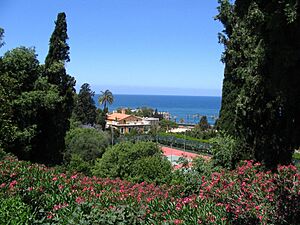
AUB Accreditation
AUB has been officially recognized, or "accredited," by the Commission on Higher Education of the Middle States Association of Colleges and Schools. This means the university meets high standards for education. AUB's accreditation was confirmed in 2004, 2009, 2016, and 2019.
Many of AUB's specific programs also have special accreditation. For example, the Graduate Public Health Program was accredited in 2006. It was the first program of its kind outside North America to get this recognition. The Rafic Hariri School of Nursing's programs were accredited in 2007.
The Suliman S. Olayan School of Business (OSB) was accredited in 2009. This is a special honor, as less than five percent of business schools worldwide have this accreditation. The Maroun Semaan Faculty of Engineering and Architecture also has accreditation for its engineering programs. The Faculty of Agricultural and Food Sciences' Nutrition and Dietetics program was accredited in 2013.
Notable AUB Alumni
AUB has over 64,000 living alumni. These are former students who have graduated from the university. They live in more than 120 countries around the world.
As mentioned before, 20 AUB graduates helped sign the United Nations Charter in 1945. One of these was Angela Jurdak Khoury, who was Lebanon's first woman diplomat.
Angela Jurdak Khoury is a very famous alumna of AUB. She was the first known woman to earn a master's degree from AUB in 1938. She became Lebanon's first woman diplomat. In 1959, she received Lebanon's highest state award.
Many other notable women have graduated from AUB and achieved great things:
- Reem Acra studied business at AUB. She became a famous fashion designer.
- Zaha Hadid studied mathematics at AUB. She became a world-renowned architect. One of her buildings is at AUB.
- Rula Ghani was a former first lady of Afghanistan. She was named one of the world's most influential people by Times magazine.
- Ghada El Samman is a famous Arab writer. She earned her master's degree from AUB and started her own publishing house.
- Karimeh Abbud, born in 1893, studied Arabic Literature at AUB. She is known as the first female photographer in the Arab world.
- Dr. Amal Mudallali studied political science at AUB. She became the first Lebanese woman to be Lebanon's UN ambassador.
- Edvick Jureidini Shayboub was a women's rights activist, author, and radio journalist. She fought for women's rights around the world.
- Lina Abu Akleh is a human rights advocate.
See also
 In Spanish: Universidad Americana de Beirut para niños
In Spanish: Universidad Americana de Beirut para niños
- Alumni of the American University of Beirut
- American University (disambiguation)
- The American University in Cairo (AUC)
- American University of Sharjah (AUS)
- American University of Iraq - Baghdad (AUB)
- American University of Iraq - Sulaimani (AUI)
- Education in the Ottoman Empire


